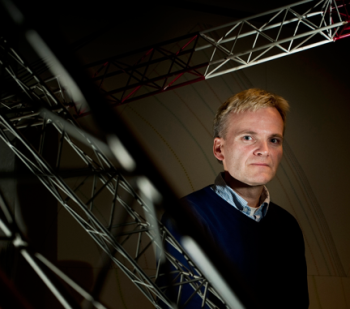May 22 2012
Offshore Wind farms are expensive to install and operate. Now, Uni CIPR geologists are transferring knowledge from the oil industry to help improve profitability in the wind power industry.
Similar to the petroleum industry, the wind power industry uses data from many different types of surveys and studies. However, the wind industry currently lacks both methods and tools to process and make concerted use of the available data for planning purposes. Developing planning tools that use integrated models of the physical environment will be an important step towards cutting installation costs and increasing the profitability of wind farm projects.
"A common platform for descriptions, planning and impact assessment, integrating information from all disciplines involved, provides a comprehensive picture of the interaction between the various environmental parameters and the planned installations. Use of common models has already proven itself to be a very effective way of organising, analysing and communicating data between the various specialist groups involved in the development of petroleum fields," says Jan Tveranger, research leader of the geoscience section at Uni CIPR.
 "This is an interesting opportunity to transfer concepts developed in the oil industry over the last 15 years to the wind power industry; for example, integrated modelling, risking and optimisation," says Jan Tveranger. Image Credit: Eivind Senneseth
"This is an interesting opportunity to transfer concepts developed in the oil industry over the last 15 years to the wind power industry; for example, integrated modelling, risking and optimisation," says Jan Tveranger. Image Credit: Eivind Senneseth
Testing at Havsul
The work on developing a common platform and analytical tools for site characterization and optimization of offshore wind farms is part of an innovation project supported by the Research Council of Norway's Clean Energy for the Future (RENERGI) programme. Here Uni CIPR is part of a broad partnership (see the "facts" box), the purpose of which is to streamline the planning, design and installation of seabed foundations for wind turbines.
The project has a budget of NOK 14 million, and the results will be published in summer 2013 and ready for use in the large, growing market for offshore wind farm projects from 2014 onwards. The The planned wind farm Havsul off the Møre coast in northwestern Norway, owned by Vestavind Offshore AS, will act as a test side for demonstrating the new technology.
Costs must be cut
Much of the Norwegian coast is characterized by a challenging climate as well as highly variable water depths and seabed conditions. This type of environment imposes major constraints on marine operations, positioning of turbine towers and the choice of foundation designs for the towers. This in turns may send the material costs and construction time through the roof. Installation costs must be reduced for offshore wind farms to become an attractive industry. Norwegian companies and research institutions are working on developing new technology and new methods to overcome these challenges.
Integrated site characterization
The single most important prerequisite for cost-effective development of wind farms is detailed knowledge and good understanding of the local environmental conditions: meteorological, oceanographic, biological and geological. The description of the environmental conditions forms the basis for the design of the turbines and towers and constrains where they can be positioned to achieve optimal power generation. Although environmental surveying is already a key part of planning work in connection with offshore wind farms, there is currently no common software or methodology that allows integrated treatment of the whole suite of environmental data. In addition, since most of the existing offshore wind farms have been built in areas with simple, relatively uniform seabed conditions, methods have not yet been developed for installation of wind power plants in areas with complex seabed geology, discontinuous cover of surficial deposits, and large variations in water depth. This can pose significant problems during installation, if the tower foundations have not been designed for and adapted to the local seabed conditions.
Facts
The Centre for Integrated Petroleum Research at Uni Research (Uni CIPR) and its partners NorWind Installer AS (project owner), OWEC Tower AS, Vestavind Offshore AS, MENCK GmbH, BAUER Spezialtiefbau GmbH and the University of Strathclyde, Glasgow have been awarded support from the Research Council of Norway for an innovation project in the field of renewable energy.
NorWind Installer AS, which installed the first jacket foundations in the German sector in 2009, will primarily focus on the installation of the new designs using their planned purpose-built installation vessels.
OWEC Tower AS, the market leader in jacket-based foundation design for offshore wind turbines, is collaborating with the other partners to develop new design solutions for pre-installed seabed foundations. The solutions will cover a broad spectrum of designs from drilled and screwed piles to suction buckets and gravity bases, using the current system of piles in sand as a reference.
The foreign partners, which have a great deal of experience from offshore wind research and industrial projects in Germany and the UK, are contributing expertise in the fields of design and installation activities.